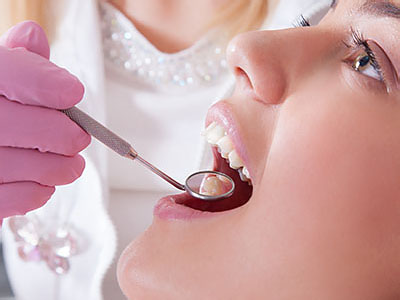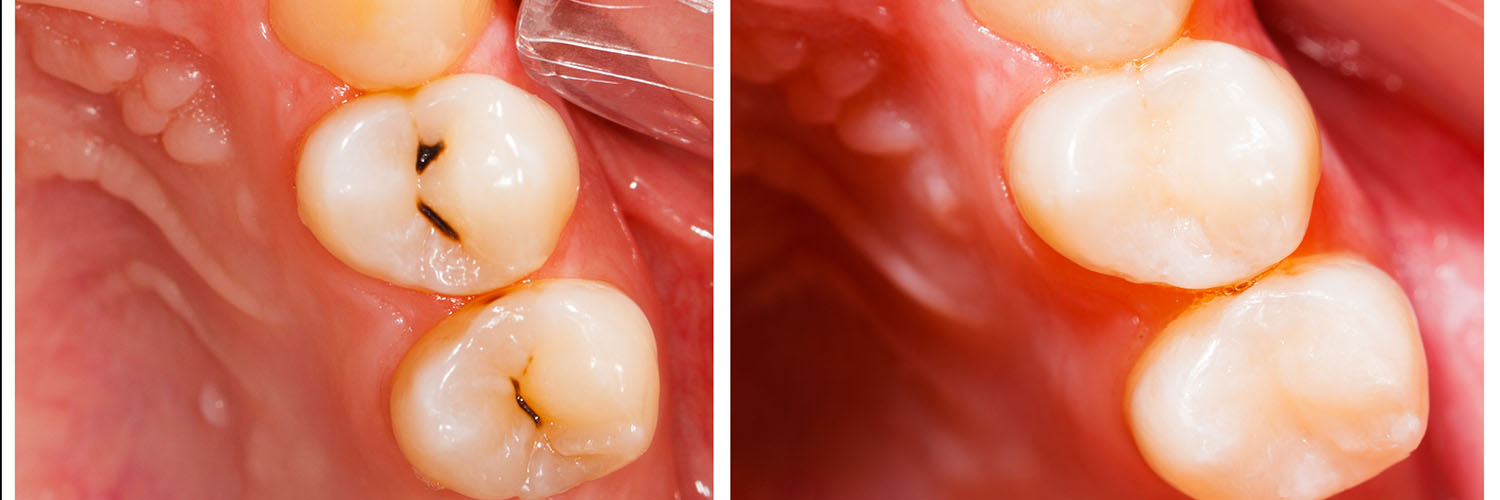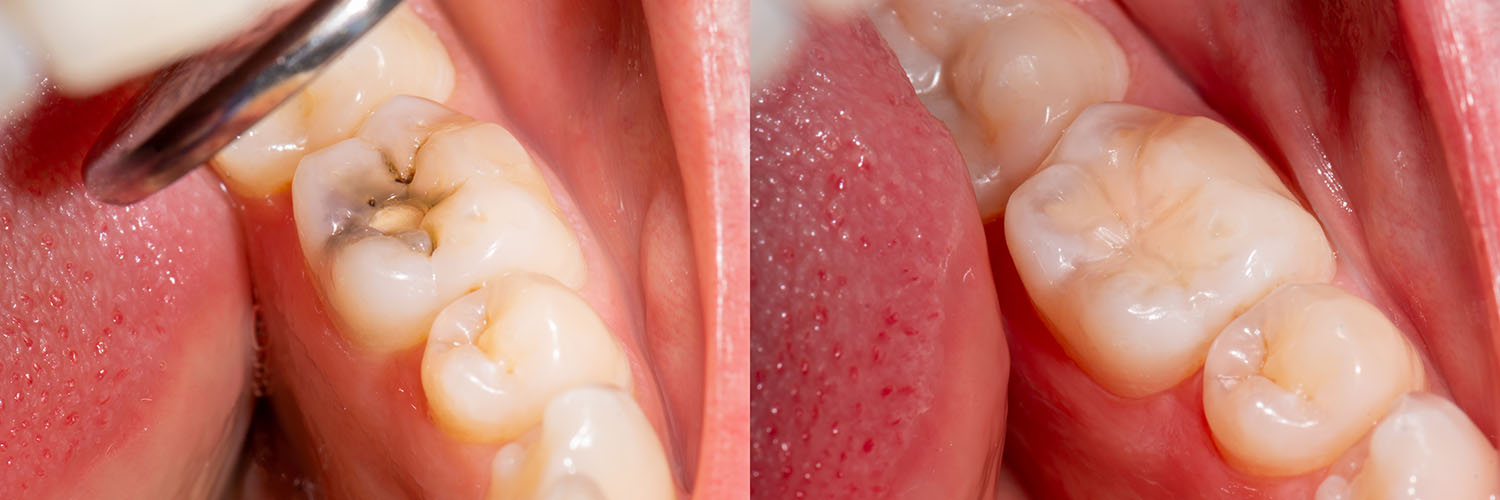
Our Office
Visit Us Online

A filling does more than cover a cavity: it rebuilds the tooth so you can chew comfortably, avoid further breakdown, and maintain the natural shape of your smile. When decay or minor fractures remove tooth structure, a carefully selected filling material fills the gap, seals the area from bacteria, and helps the tooth withstand normal biting forces.
Modern fillings are designed with both function and appearance in mind. Advances in materials and techniques allow clinicians to match color, contour, and surface texture so restorations blend with surrounding teeth while offering reliable performance. That combination of durability and discreet aesthetics is why fillings remain one of the most common restorative treatments in dentistry.
At Towne Dental & Orthodontics, our approach emphasizes preservation—removing only the compromised tissue while supporting remaining healthy tooth structure. We’ll explain why a filling is the right option for your situation, and how the chosen material aligns with long-term oral health goals.
Human efforts to repair damaged teeth date back thousands of years, and the evolution of filling materials reflects centuries of trial and innovation. Early civilizations used natural substances and rudimentary techniques; by the 19th and 20th centuries, metal alloys like gold and dental amalgam became widespread because of their strength and longevity.
In recent decades, concerns about appearance and biocompatibility drove development of tooth-colored restoratives. Composite resins, glass ionomers, ceramics, and high-quality porcelains now give clinicians multiple ways to restore function without compromising cosmetics. These options let patients choose restorations that align with their priorities for appearance, performance, and conservation of tooth structure.
Selecting a filling material is a clinical decision that balances the location and size of the cavity, the amount of remaining tooth, bite forces in the area, and aesthetic priorities. Small lesions on visible front teeth typically call for esthetic, adhesive materials; back teeth that endure heavy chewing may benefit from more wear-resistant options.
We also consider reparability and future maintenance. Some materials are easy to repair or adjust in the office, while others may require laboratory fabrication or replacement if they fail. During your visit, we’ll discuss advantages and trade-offs so you can make an informed choice that suits your lifestyle and oral health goals.

There is no single “best” filling material—each has strengths and limitations. Understanding the main categories helps patients appreciate how options match different clinical situations: some prioritize natural appearance, others emphasize durability or fluoride release for added protection.
Below are commonly used materials and what they offer. Your clinician will recommend the one that provides the best balance of aesthetics, strength, and longevity for your tooth.
Composite resins are a blend of resin matrix and finely ground glass or ceramic fillers that harden when exposed to a special light. They are available in multiple shades to closely match natural enamel, and they bond directly to the tooth, which can reinforce remaining structure. These properties make composites a popular choice for visible teeth and conservative restorations that preserve more natural tooth.
Composites are versatile—used for small to moderate cavities and for cosmetic bonding tasks. Although they may be more susceptible to staining and wear than ceramic options, proper polishing, good oral hygiene, and routine dental care help extend their life.
Amalgam is a traditional restorative material composed of a metal alloy. It has a long history of durability and is particularly effective where strength is the highest priority, such as large restorations on back teeth. While not tooth-colored, amalgam can offer a cost-effective, long-lasting seal in areas that aren’t highly visible.
Glass ionomers bond chemically to tooth structure and release small amounts of fluoride, which may help protect against recurrent decay. Because they are less wear-resistant than composites or ceramics, they are often chosen for pediatric dentistry, for repairing root surfaces near the gumline, or as temporary restorations while a longer-term solution is planned.
Ceramic restorations are crafted from high-quality dental porcelains and offer outstanding color stability and resistance to wear. Inlays and onlays are indirect restorations fabricated in a dental laboratory or in-office milling unit; they preserve more tooth than a full crown and provide a durable, esthetic result for larger defects that are too extensive for a direct filling.
Although used less frequently today, gold restorations are known for their excellent fit and longevity. They are biocompatible and very resistant to wear, making them a sensible option in specific cases where function and durability outweigh cosmetic concerns.

A filling visit is generally straightforward but tailored to your comfort and the tooth’s needs. The process usually begins with an exam and digital images as needed to determine the extent of decay and the right restorative plan. Before work begins, the area is numbed so you remain comfortable throughout the procedure.
Decay is gently removed using precise instruments, lasers, or air-abrasion tools depending on the situation. Once the cavity is cleaned and prepared, the chosen material is placed and shaped to restore natural contours. Adhesive materials are bonded in layers and cured with a light; indirect restorations may require impressions and a follow-up visit for final placement.
Most direct fillings can be completed in about an hour, though extensive repairs or multiple restorations may take longer. The clinical team will confirm your bite is comfortable and make any fine adjustments before you leave.
If you feel anxious about dental treatment, tell us—there are proven approaches to relaxation and comfort that we can discuss so your visit is as calm and manageable as possible.
After a filling, it’s normal to notice temporary sensitivity or an unfamiliar sensation as the tooth and surrounding tissues settle. Sensitivity to hot, cold, or pressure typically resolves within a few days; if discomfort persists or intensifies, contact our office so we can reassess the restoration and bite.
Protecting a fresh filling begins with basic oral hygiene: brushing twice daily with fluoridated toothpaste, flossing once a day, and maintaining regular dental checkups. Avoiding hard or sticky foods for a short time after placement reduces the risk of dislodging or stressing a new restoration.
With proper home care and periodic professional evaluation, most fillings perform well for many years. When a restoration shows signs of wear, recurrent decay, or marginal breakdown, replacing or upgrading the restoration can prevent more extensive treatment later on.
Our team at Towne Dental & Orthodontics is available to answer questions about care, monitor the condition of restorations over time, and recommend tailored strategies to protect your smile for years to come.
If you suspect a cavity or have a tooth that feels different, an evaluation is the best first step. Early detection allows for more conservative treatment and better long-term outcomes. During your visit, we will review findings, explain the restorative options, and work with you to select a solution that fits your needs and priorities.
Our goal is to preserve natural teeth whenever possible, provide restorations that look and perform naturally, and keep you informed at every stage of care. Whether a small composite filling or a more involved inlay is recommended, expect clear explanations and careful execution focused on lasting results.
For additional information about dental fillings or to discuss an upcoming appointment, please contact our office. We’re here to help you protect your oral health and keep your smile functioning and looking its best.
If the pleasure of eating a delicious bowl of ice cream or sipping a soothing cup of tea gets overshadowed by dental pain that makes you wince; it's time to contact our office. As skilled providers of care, we'll determine what's causing your discomfort and perform the treatment required to alleviate your symptoms and get you back on the road to oral health.
Cavities develop because of an infectious process that causes progressive damage to tooth structure. Despite starting as a pinpoint defect on the outermost enamel layer of your tooth, untreated dental decay progressively compromises more and more healthy tooth structure as it works its way to the inner layers of your tooth.
Yes, you can still develop tooth decay on other surfaces of the tooth, around the margins of an old filling, or in fewer instances, recurrent decay underneath it. For this reason, it's essential to maintain excellent oral hygiene, a diet low in sugary beverages and sweets, and be sure to visit our office for routine checkups and care. While tooth decay is second only to the common cold in frequency, it's almost entirely preventable.
We value the time and comfort of our patients. If cavities are located on adjacent teeth, or in the same section of your smile, it may be possible to treat more than one tooth during your visit. However, how much is done each visit depends on several factors. We keep our patients well informed and tailor every treatment plan and visit to address their unique needs.
Addressing concerns on the presence of elemental mercury in silver fillings, the American Dental Association (ADA), The Center for Disease Control and Prevention (CDC), the FDA, and the World Health Organization have all stated that amalgam restorations do not pose a risk to health. However, individuals with allergies or sensitivities to the metals in dental amalgam are advised to pursue other restorative options.
Dental fillings are performed under local anesthesia to help ensure your comfort throughout the entire procedure. The involved tooth remains completely numb for the extent of your visit. Within one or two hours after the procedure is completed, the local anesthetic will gradually wear off, and normal sensations return.
A tooth-colored composite filling is fully hardened and set by the end of your visit. However, we may advise you to wait a couple of hours until the local anesthesia has completely worn off. This advice is to help ensure you don't accidentally bite your lip, cheek, or tongue while still numb.
The lifetime of a dental filling varies depending on the type of material used. While popular dental materials can last a decade or more with proper care, they can degrade over time, wear down, or even break. When this happens, you may experience some tooth sensitivity, a jagged edge, or a loose or dislodged piece of filling material. Whatever the case may be, it's essential to get the filling replaced before the tooth sustains further damage or other consequences arise. Beyond taking good care of your smile to help ensure the longevity of your fillings, our office regularly checks the status of your existing fillings as part of a routine checkup exam.
Dental fillings are an essential investment that serves to preserve and protect the health of your smile. With that said, how much a filling costs depends on the number of surfaces of the tooth involved and the filling material that is used. Amalgam restorations are the most economical. While tooth-colored composite fillings have a slightly higher cost, they offer the added benefits of being metal-free and much more aesthetically pleasing. Ceramic fillings, inlays, and onlays are more expensive than the preceding options but provide outstanding, long-lasting, and natural-looking results.
Dental insurances typically cover the cost of dental fillings. While we work with you to maximize your insurance benefits, there may still be an out-of-pocket expense. At the office of Towne Dental & Orthodontics, we strive to help you begin care without any additional financial stress or delay.
A dental filling replaces tooth structure lost to decay or minor fracture and restores the tooth's shape so you can chew comfortably. Fillings seal the prepared area to prevent bacteria from re-entering and causing further damage. By rebuilding the missing structure, a filling helps maintain proper bite alignment and overall oral function.
Treating small cavities early with a filling is a conservative approach that preserves as much natural tooth as possible. When left untreated, decay can progress deeper into the tooth and lead to more complex care such as root canal therapy or full coverage restorations. Regular examinations and early intervention make fillings an effective tool for preventing more extensive treatment.
Modern dentistry offers several restorative materials, each with distinct properties for strength, appearance, and longevity. Common options include tooth-colored composite resins, glass ionomer cements that release fluoride, traditional amalgam for high-wear areas, ceramic inlays and onlays for larger defects, and gold or specialty alloys when extreme durability is needed. The choice depends on the tooth's location, the extent of the defect, and aesthetic priorities.
Newer materials emphasize conservation of healthy tooth structure and improved aesthetics while retaining reliable performance under chewing forces. Some materials bond to the tooth and help reinforce remaining structure, while others are fabricated indirectly for enhanced wear resistance. Your clinician will explain the trade-offs so you can select the option that best fits your needs.
Selecting the right filling material involves assessing the size and location of the cavity, the amount of remaining tooth structure, and the forces that tooth will endure during chewing. Aesthetic concerns, such as whether the tooth is visible when you smile, and functional priorities, such as durability in a back molar, are both part of the decision-making process. The presence of previous restorations, the need for repairability, and any underlying dental conditions also influence the recommendation.
At Towne Dental & Orthodontics we discuss these clinical factors with patients so recommendations align with long-term oral health goals. Your clinician will present options, explain expected performance and maintenance needs, and help you make an informed choice that balances appearance, strength, and conservation of tooth structure.
A filling appointment typically begins with an exam and any necessary digital images to evaluate the extent of decay and plan the restoration. The treatment area is numbed using local anesthesia to keep you comfortable, and in many cases the dentist can remove decay with small rotary instruments, air abrasion, or a laser device such as the Solea system for minimally invasive preparation. Once the cavity is clean, the chosen material is placed, contoured to restore natural anatomy, and the bite is adjusted to ensure comfort.
Direct fillings can often be completed in a single visit, while indirect restorations like ceramic inlays or onlays may require impressions and a follow-up appointment for final placement. The clinical team will check occlusion, polish the restoration, and review aftercare instructions before you leave. If you experience anxiety, tell your provider so they can discuss comfort options to make the visit more manageable.
Most patients experience little to no pain during a filling because the area is numb with local anesthesia before work begins. Modern techniques and options such as topical numbing agents or laser-assisted treatments can further reduce the need for needles or minimize sensation for anxious patients. During the procedure you may feel pressure or vibration but not sharp pain.
After the anesthesia wears off you can expect temporary sensitivity to hot, cold, or pressure as the tooth adjusts to the restoration. This sensitivity usually subsides within days to a few weeks; if discomfort persists or becomes worse, it should be evaluated so any necessary adjustments or further treatment can be made.
Caring for a new filling begins with consistent oral hygiene: brush twice daily with fluoride toothpaste and floss once a day to remove plaque and reduce the risk of recurrent decay. Avoid very hard or sticky foods for a short period after placement to allow the material to fully set and to prevent premature stress on the restoration. Maintaining routine dental checkups and professional cleanings helps the team monitor the restoration and catch any early signs of wear.
If you notice persistent sensitivity, roughness, or a change in bite after a filling, contact the office so the dentist can reassess and make adjustments if needed. For adhesive restorations, periodic polishing and good home care help preserve appearance and longevity. Using a night guard or other protective appliance may be recommended for patients who clench or grind, which can extend the life of restorations.
Fillings can last many years, but longevity varies by material, location in the mouth, oral habits, and oral hygiene. Materials such as ceramics and gold alloys tend to resist wear longer, while composites and glass ionomers may require maintenance or replacement sooner depending on chewing forces and staining. Regular dental examinations allow your clinician to evaluate marginal integrity, wear, and any recurrent decay that might necessitate repair or replacement.
Signs that a filling may need attention include persistent sensitivity, visible cracks or gaps at the margin, rough or worn areas, and discoloration around the restoration. Addressing these issues early can prevent more extensive treatment and help preserve the underlying tooth structure.
Many filling materials used for adults are also appropriate for children, but selection often prioritizes durability, ease of placement, and preventive benefits. Glass ionomer cements, for example, are commonly used in pediatric dentistry because they bond to tooth structure and release fluoride, which can help protect primary teeth. Composite resins are also used for visible primary teeth when aesthetics and tooth preservation are important.
When treating children, clinicians also consider behavior management, the lifespan of the primary tooth, and the child’s ability to tolerate the procedure. In some cases temporary restorations or stainless steel crowns are chosen for primary molars that have extensive decay or for children who need a durable, low-maintenance solution.
Inlays and onlays are indirect restorations fabricated outside the mouth and then bonded to the tooth; they are often made from ceramic or gold and provide a strong, precisely fitting solution for larger defects. These restorations preserve more natural tooth structure than a full crown while offering superior fit and wear resistance compared with large direct fillings. Inlays fit within the cusps of the tooth, while onlays extend over one or more cusps when additional coverage is needed.
Clinicians recommend inlays or onlays when a cavity or fracture is too extensive for a direct filling but the tooth does not require full coverage. The process typically involves preparing the tooth, taking an impression or digital scan, and returning for final cementation once the restoration is fabricated, resulting in a conservative and long-lasting outcome.
Preventing future cavities combines effective daily habits with professional care: brush twice daily with fluoridated toothpaste, floss daily, and limit frequent exposure to sugary or acidic snacks and beverages. Using fluoride treatments as recommended, drinking water, and chewing sugar-free gum after meals can help remineralize enamel and reduce bacterial acid activity. Dental sealants may be recommended for children or adults on deep grooves in back teeth where plaque tends to accumulate.
Regular dental examinations and cleanings enable early detection of small lesions that can be treated conservatively before they require larger restorations. Discussing individualized preventive strategies with your dental team, including dietary guidance and protective appliances for clenching or grinding, further lowers the chance of future restorative needs.